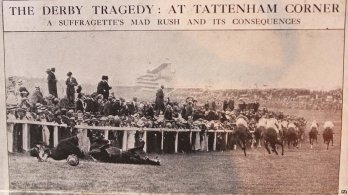Was she making a protest in the name of suffrage? Was she simply trying to make a statement; not actually intending to be fatally struck by a horse? Or was it an intentional suicide?
The memorable event occurred on the 4th of June 1913 at the Epson Derby. The theory that has been wid ely accepted was that she was making a statement for the Suffragettes. She joined the “Women’s Social and Political Union” seven years prior to the incident and began protesting for women’s rights. She was arrested nine times in her life and force fed 49 times therefore she was evidently an active promoter of women’s suffrage. This would indicate that her jumping in front of the horse was a protest rather than an accident or a suicide and was thus a martyr. What is even more convincing is the fact that Emmeline Pankhurst wrote in her autobiography that Davison believed “the deliberate throwing into the breach of a human life, would put an end to the intolerable torture of women”.
ely accepted was that she was making a statement for the Suffragettes. She joined the “Women’s Social and Political Union” seven years prior to the incident and began protesting for women’s rights. She was arrested nine times in her life and force fed 49 times therefore she was evidently an active promoter of women’s suffrage. This would indicate that her jumping in front of the horse was a protest rather than an accident or a suicide and was thus a martyr. What is even more convincing is the fact that Emmeline Pankhurst wrote in her autobiography that Davison believed “the deliberate throwing into the breach of a human life, would put an end to the intolerable torture of women”.
However, there has been criticism of this theory and this can be seen through the statement made by PC. Eady at the time “I did not at any time whilst on t he course, see any suffragette badge, flag, or card displayed”. This suggests that Davison did not have an ulterior motive for the Suffragettes meaning she may have committed suicide. On the other hand, when looking at sources they must be critiqued. A lot of people saw the Suffragettes as a threat to society, and as a police officer PC. Eady may have been told to lie therefore Samuel Eady may have fabricated his statement.
he course, see any suffragette badge, flag, or card displayed”. This suggests that Davison did not have an ulterior motive for the Suffragettes meaning she may have committed suicide. On the other hand, when looking at sources they must be critiqued. A lot of people saw the Suffragettes as a threat to society, and as a police officer PC. Eady may have been told to lie therefore Samuel Eady may have fabricated his statement.
Although the answer is not certain, this brief summary of the Emily Davison’s death demonstrates that she was supporting the Suffragettes by jumping in front of the King’s horse. Whether there was evidence of her carrying a badge or a flag is irrelevant because you can see prior to this event she was a highly active protester for women’s rights.

Bibliography:
British Library, “Emily Davison killed at the 1913 Derby” URL: http://www.bl.uk/learning/histcitizen/21cc/struggle/suffragettes1/derby1/derby.html (Last accessed – 12/10/16)
Jonathan Brown, “Suffragette Emily Davison: The woman who would not be silenced”, The Independent, (24 May 2013), URL: http://www.independent.co.uk/news/uk/home-news/suffragette-emily-davison-the-woman-who-would-not-be-silenced-8631791.html (Last accessed – 12/10/16)
Briony Paxman and Clare Horrie, , “Emily Davison and the 1913 Epsom Derby”, The National Archives, (4 June 2013), URL: http://blog.nationalarchives.gov.uk/blog/emily-davison-and-the-1913-epsom-derby/ (Last accessed – 12/10/16)
Vanessa Thorpe,”Truth behind the death of suffragette Emily Davison is finally revealed”, The Guardian, (2013), URL: https://www.theguardian.com/society/2013/may/26/emily-davison-suffragette-death-derby-1913 (Last accessed – 12/10/16)
Elizabeth Crawford, ‘Emily Wilding Davison: Centennial Celebrations’, Women’s History Review, 23 (2014), P. 1000–1007
Image URL’s:
Main image – Northumbria University, https://makinghistoryatnorthumbria.wordpress.com/2014/01/28/emily-davison-martyr-or-mistake/ (Last accessed 12/10/16)
Emily Davison – Mike Kelly, The Chronicle, (29 March 2015), URL: http://www.chroniclelive.co.uk/news/north-east-news/makers-film-suffragette-starring-meryl-8937101 (Last accessed 12/10/16)
“The Derby Tragedy” – https://uk.pinterest.com/pin/352477108306866920/
PC. Eady’s statement – Briony Paxman and Clare Horrie, , “Emily Davison and the 1913 Epsom Derby”, The National Archives (4 June 2013), URL: http://blog.nationalarchives.gov.uk/blog/emily-davison-and-the-1913-epsom-derby/ (Last accessed – 12/10/16)

I like the look of your blog. Navigation is straightforward and your title “Ed Talks” is inspired! The choice to pose some opening questions in bold is an effective hook for the reader.
I found the content derivative rather than original – EWD’s protest and subsequent death is a much discussed topic and I felt your contribution here didn’t really take it any further or add anything new. Perhaps there is scope to develop the issue of how EWD’s action were used by others to their own ends? For example the reference to Emmeline Pankhurt’s later recollections is interesting – to depict Davison’s death as deliberate was deemed the most appropriate interpretation, irrespective it seems of the evidence to the contrary.
You might also consider, why is this incident still of so much interest today?
Your bibliography is well presented but consider using a range of sources. There is a book by Stanley & Morely ‘The Life and Death of EWD’ that offers compelling evidence that her intention was to make a protest rather than commit suicide.
Stylistically, check spelling – Epsom (not Epson) and review your approach to use of inverted commas and capital letters.
LikeLike